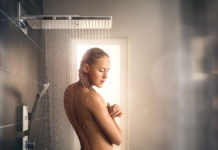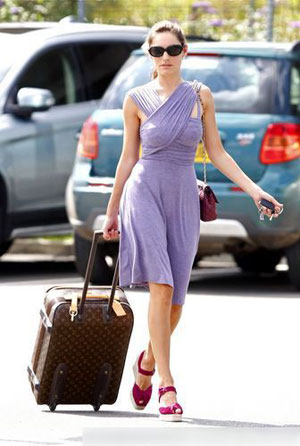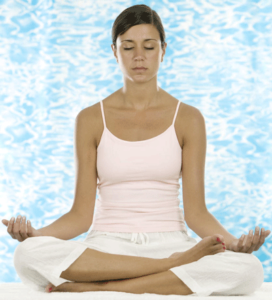“I cannot think clearly when my feet hurt!” – President Abraham Lincoln, 16th US President, 1861-1865
“Remember the longest journey starts with just one step.”
“If you pick them up, O’Lord, I’ll put’em down.” – Prayer of Tired Walker
“The average American has their feet encased in shoes for over 12 hours daily and most often the shoes are ill-fitting, resulting in foot problems.”
Clean Feet Are Important
Like the rest of your body, feet perspire. Each foot has thousands of sweat glands and because they’re usually encased in shoes, socks or stockings, they retain more perspiration than less-restricted parts of the body. This can lead to unpleasant odors and accumulation of rough or dead skin that causes irritation and soreness.
You must tackle foot-bathing with real dedication and vigor. Keep the following items handy, right next to your tub or shower: a handbrush with moderately stiff bristles, a worn-out toothbrush and a pumice stone.
First, scrub your feet with the handbrush. Use health soaps (tea tree, vegetable, herbal, oatmeal, glycerine, etc.) and warm water. Do not neglect the soles of the feet. Next, scrub between the toes. Here is where you use the toothbrush, because these places are hard to get at otherwise. It’s particularly important to get your feet absolutely clean because this helps to prevent athlete’s foot, which is one of the most irritating of foot problems.
Now rinse feet and while they’re still wet, if in shower sit down on shower stool and rub the pumice stone or foot file lightly on any foot parts that feel rough. This usually includes the heels and balls of feet. Use the stone with a gentle, rotary motion, as this helps to soften the skin and discourages heavy calluses from forming.
Drying your feet is very important. Athlete’s foot is caused by a fungus that thrives on warm, damp skin. If you do not dry the foot thoroughly, especially between the toes, you are inviting this fungus which is difficult to overcome. Do not scrub-dry the areas between your toes. Pat them dry, gently but firmly. Otherwise, you may irritate these areas. The rest of the foot you may dry vigorously. In fact, this form of brief massage has the added advantage of stimulating foot circulation.
 Pedicure and Trimming The Toenails
Pedicure and Trimming The Toenails
A good time to give yourself a pedicure is after your foot bath, when skin is warm and moist. You can gently push back the cuticle and rid toenails of excess cuticle that forms around nails. This habit prevents cuticles from growing wild. (For salon pedicures be sure the instruments are sterilized or take your own.)
When trimming your toenails, please never rip any off. This may leave a torn edge that can become extremely sensitive to shoe pressure. Also, never trim down into the corners of a nail as this is one of the chief causes of ingrown toenails. Trim the toenails straight across and leave the corners alone. Remember – ingrown toenails, corns, calluses, bunions and Athlete’s Foot – all detract from the health, appearance and happiness of your feet!
Remember that the basic purpose of foot hygiene is to maintain a healthy tone and vigor in each foot, just as strengthening-up exercises are designed to keep the body trim. Hygienic foot-care is a routine habit that pays great dividends in healthier feet to carry you through life.
Finish off your pedicure with a massage using our Bragg Organic Extra Virgin Olive Oil to keep your feet flexible, soft and smooth. This oil is also great for the legs, arms, face and the entire body.
Baby Your Tired, Aching Feet
Tired, hurting feet can take the joy out of your life! This book is filled with ways to bring life back to your feet! Some methods are a little more elaborate than others, but all are just variations of foot care therapy: various special foot soaks (herbal, vinegar, Epsom salts), foot therapy, pedicure, massage, exercise and rest.
The following special foot bath will prove beneficial. Sit on a chair next to the bathtub with your feet dangling under the tap. Turn on tap to make a strong flow for 5 to 10 minutes, alternating hot and cold water over feet (diabetic & heart patients caution using hot water). If you have a spray attachment, just spray alternating directly hot, then cold water, on your feet – feels so great!
After your foot bath, dry your feet thoroughly with a rough towel and be sure that all moisture is off the feet. Now sprinkle cornstarch over your feet and start your foot massage, using fingers, mainly thumbs, in a circular motion. Start on the bottoms of the feet. Put plenty of powder on your hands and massage the soles of your feet in rotary motion. With both hands, twist each foot back and forth in opposite directions to keep them limber and healthy. Then massage the sides and ankles in a rotary motion. Also, gently pull and twist each toe from its base. End up with a stroking massage motion. Don’t be afraid to use pressure as this promotes more healthy blood circulation to the general structure of the feet and ankles, and helps wash the toxins and crystals out of the feet!
Please keep in mind that massage is very important in making the feet healthy, alive and tingling with vitality. Circulation reaches its weakest point in the feet because the heart has to drive blood down there; they are farthest from the heart and blood must flow against gravity to return to the heart. Hence, circulation may often become sluggish in the feet (cold and aching feet are two of the signs of poor circulation).
Expert Advice on Banishing Athlete’s Foot
Our body is normally the host to a variety of microorganisms, including bacteria, mold-like fungi and yeast-like fungi. Some of these micro-organisms are useful to our body, but others may cause infections. Fungal skin infections are caused by microscopic fungi that can live on the skin. Athlete’s Foot is the most common and most persistent of the fungal (tinea) infections. Athlete’s Foot may occur in association with other fungal skin infections such as ringworm or jock itch. Mold-like fungi live on the dead tissues of the hair, nails and the outer skin layers and thrive in the warm, moist areas of the body.
Athlete’s Foot is a skin disease caused by fungi which occurs usually between the toes. The fungus attacks the feet because shoes create a warm, moist environment which encourages its growth. Poor hygiene, prolonged moist skin and minor skin or nail injuries are also factors that can induce Athlete’s Foot. Some symptoms to watch out for are: itching, stinging or burning, skin redness, rash or blisters, inflammation and discoloration and crumbling nails.
Athlete’s Foot is contagious! It can be spread through items such as shoes, socks and shower and poolside surfaces of spas, clubs, summer camps, etc.Athlete’s Foot may spread to the soles of the feet and toes, plus other body parts, notably the groin area and the underarms.
If you have Athlete’s Foot, using self-care can help you banish the problem: Put 1/3 cup of Bragg Apple Cider Vinegar in shallow pan of warm water and soak feet once daily until gone (ideal while reading or watching TV); always keep feet clean and dry; always wear clean cotton or wool socks, change daily; wear shoes made of natural material such as leather, or canvas and best to alternate shoes daily. Shoes then have time to dry completely between wearings; reduce perspiration by using cornstarch powder. When you are infected with Athlete’s Foot, it’s good to change bed sheets and clothing often to prevent the infection from spreading.
Why should emphasis be placed upon such a simple thing as the pull of gravity? This is very easy to explain. In youth, as long as your muscles were strong enough, they held your skeleton in proper balance with its many points and sections free from strain or discomfort. As your body ages, your muscles start to lose the battle with gravity, especially if you are prematurely ageing or heavier than you should be, or a forced rest has weakened your muscles just enough to cause an uncomfortable state of body imbalance. Slumping stretches your back’s ligaments and causes backaches. Ligaments are meant to serve only as check reins for the joints and they cannot be forcibly stretched without, in time, causing pain.
When the ligaments in your back are made stiff and uncomfortable by this, it’s only natural for your muscles to try to oppose this sagging of your back which results from the pull of gravity (poor posture). However, when your muscles are too weak to do their job, they rapidly become exhausted and develop fatigue, making good posture impossible and your back even more uncomfortable!
Check your own posture and symptoms. Do you notice a deep aching and soreness along your spine due to stretched ligaments? Are your back and shoulder areas achy and tired? Is your backache due basically to weak muscles? If it is, it’s about time you did something sensible to relieve it, like strengthening all those weak muscles by proper exercise and posture.

























